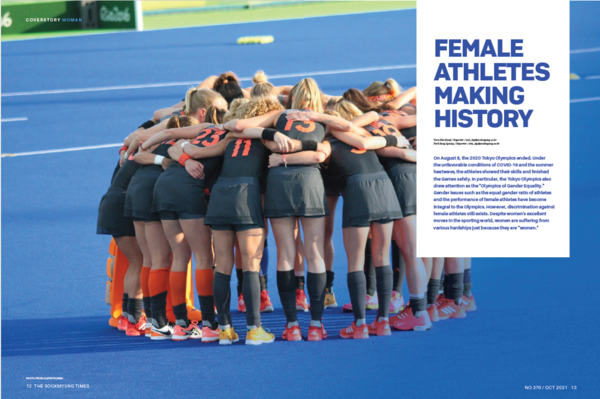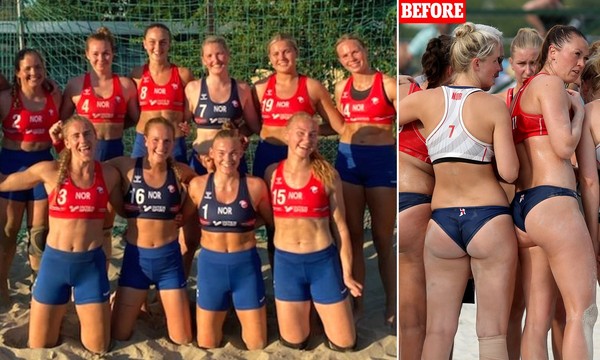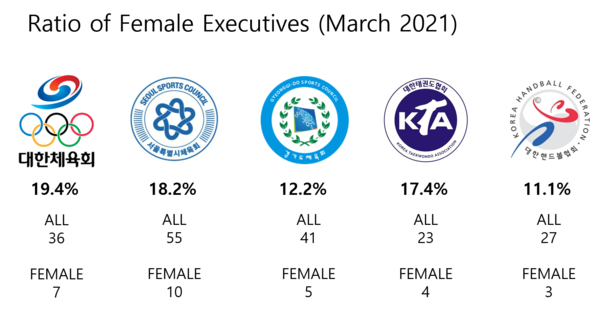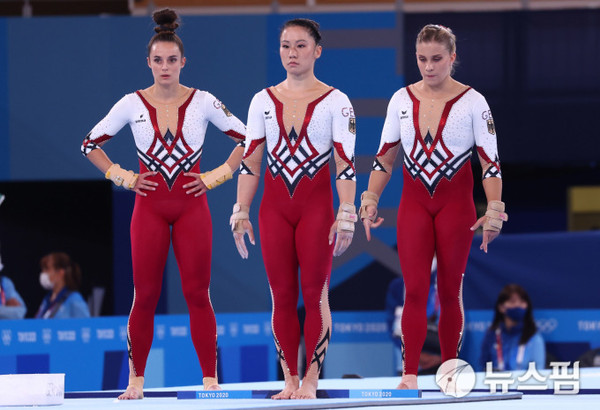
On August 8, the 2020 Tokyo Olympics ended. Under the unfavorable conditions of COVID-19 and the summer heatwave, the athletes showed their skills and finished the Games safely. In particular, the Tokyo Olympics also drew attention as the "Olympics of Gender Equality." Gender issues such as the equal gender ratio of athletes and the performance of female athletes have become integral to the Olympics. However, discrimination against female athletes still exists. Despite women's excellent moves in the sporting world, women are suffering from various hardships just because they are "women."

How far have women come
Sports being originally the domain of men has changed throughout history. All athletes dream of going to the Olympics, but it has not been long since gender equality was achieved in the Games. Unlike the Tokyo Olympics, where the proportion of female athletes was nearly half of the total athletes, the past was very different. The Olympic barriers to women were high and at the first Olympic Games in Athens in 1896, there were no female athletes. The first time that female athletes were allowed to compete was at the 1900 Paris Olympics, and even then, there were only a very small number of female athletes, only 22 out of a total of 997 athletes. It was not until 1991 that the regulation stating that new sports added to the Olympics must have women's competitions was established. Over time, the number of events that women can participate in has increased slowly. The 2012 London Olympics was the first time that female athletes from all participating countries competed in all sports. Through this process, interest in women's sports has increased, and women broke down barriers eliminating discrimination.
Many women have broken the mold to achieve equality or just to be allowed to play sports. For example, Kathrine Switzer was the first woman to officially run the Boston Marathon in 1967 when the marathon was considered to be a men's only race. She completed the marathon with the belief that if she gave up, women's sports would be further regressed rather than advanced. Eventually, women were allowed to run in the marathon in 1972. As such, there have been female athletes who became the 'first athletes' for women's participation in sports and now, there are athletes who strive to resolve discrimination against women in sports. Ji Soyeon, a soccer player of Chelsea FC Women, confessed, "At first, we played in a vacant lot when the men soccer players played in the home stadium. So I told the coach that female players should be treated the same. I was skeptical that this would change, but I thought I had to keep raising my voice, or otherwise, nothing would change."1) As she mentioned, even if athletes perform equally in the same sport, many female athletes have been discriminated against compared to male athletes. Despite the efforts of female athletes, gender equality has yet to be achieved in sports.

Kathrine Switzer running the Boston Marathon
Gender inequality in sports
The primary value of sports is showing the athletes' excellence, but sports demands 'sexuality' in addition to physical excellence from female athletes. The most controversial issue is the uniforms of female athletes. The fundamental problem surrounding uniforms lies in the system that connects players' clothes with sexual objectification. The purpose of the sports uniform regulations is to increase the activity of the players and block fouls while playing. However, certain styles which cause sexual controversies are sometimes forced. For years, female athletes in beach sports have complained that wearing bikinis is demeaning and unrealistic. On July 18, the Norwegian women's beach handball team was fined 1500 euros (approximately 2 million won) for wearing regular shorts instead of bikini bottoms in the Euro 2021 tournament. According to the International Handball Federation regulations, female players must wear bikini bottoms that do not exceed 10 centimeters in width and are tight to the body. On the other hand, male players are allowed to wear shorts that are longer and not too baggy. Julie Aspelund Berg, the player of the women's beach handball team, said, "When we wear a bikini, the bottoms are rolled up while playing, so we have to check that it is always in place. Because of this, we have to pay attention to things that have nothing to do with the game. We want to be treated like men."2) Berg pointed out that when women athletes compete, what they wear is as much a topic of discussion as the skills they show.
Another type of gender discrimination in sports is the shortage of female executives and leaders. Although women's achievements in sports performance are increasing, there are few women executives in sports. As of March 2021, the number of female executives in major sports organizations such as the Korea Sports Council was 7 out of 36 executives and 10 out of 55 in the Seoul Sports Council. Professor Nam Yoonshin of Sports for All at Duksung Women's University said, "The problem is that women are excluded from decision making and discussing financial support. It is necessary to ensure some proportion of female executives and leaders until women are given equal status as men in the male dominating sports world."3) In other words, the exclusion of women from participation in the decision-making process is a factor behind the gender discrimination structure in sports. In addition, since the revelation of sexual assault allegations by a female national ice-skating team member in 2018, the need for female coaches and leaders has increased. Lee Tanhee, a member of the National Assembly, emphasized that "With violence and sexual violence in the sports community occurring every year, it seems necessary to hire more female coaches to protect female athletes."4) As he states, sexual violence in sports has constantly occurred due to the gender imbalance between athletes and coaches.
Moreover, equal pay for male and female athletes has been one of the biggest issues in sports recently. Discrimination against female athletes is clear in that their wages are significantly lower than that of male athletes. Also, there is a huge difference in prize money for male and female athletes in global professional sports competitions. Rewards for the same efforts are given differently according to gender. The Korean men's and women's soccer teams both reached the World Cup finals in 2017 and 2018. However, the men's national team was confirmed to qualify for the 2017 World Cup and received a total of 2.5 billion won. Depending on the level of contribution, each player received the money in the range of 40 to 100 million won. A total of 180 million won in prize money was paid to the women's team that qualified for the World Cup finals the following year. The money given to each player was only about 800,000 won. Not only in soccer but also in golf, the difference in the rewards that athletes receive is enormous. The US men's golf PGA prize money is 475 billion won which is six times more than the US women's golf LPGA's 81.6 billion won. These cases show that economically, there are many limits to gender equality in sports.

Norwegian women's beach volleyball team

Those who fight discrimination
Efforts continue to be made to correct discrimination in the sporting world. At the Tokyo Olympics, the German national team's move to protest against female athletes' sexual objectification drew attention. On July 25, in the women's gymnastics preliminary round, the German national team appeared in unitards that covered their legs. Formerly, female gymnasts competed in leotard uniforms that exposed their legs and were skintight. However, with their legs exposed, players had to suffer from concerns about sexual objectification. While male gymnasts can wear loose pants, uncomfortable practices have continued for females. Under such circumstances, the German gymnastics team's new attempt conveyed a message of criticism not only in the gymnastics world but also in other sports events that emphasize unnecessary beauty. Elizabeth Seitz of the German team said, "We wanted to show every woman that they can choose what to wear for themselves. The uniforms that we wear will change from day to day depending on how we feel, what we want."5) Seitz also suggested that female athletes should be able to have control over their uniforms. Olympic Broadcasting Services has stated that it does not approve close-ups of female athletes or images that can be sexually targeted. Due to the players' actions, many people have become more interested in the problem of the sexual objectification of female athletes.
In addition, the sporting world is increasing the proportion of female executives and female leaders. The International Olympic Committee recommends that the percentage of female executives in the IOC be 30%. The proportion of female board members at the Korea Sports Council has also been expanded. On April 9, Lee Kiheung, the chairman of the Korea Sports Council, appointed the 41st executive branch directors of the Korea Sports Council. Female directors accounted for a total of 12 out of 42, up about 10% from only 16% last year. Meanwhile, the proportion of referees and coaches, who can directly affect a game, is expected to increase. The World Badminton Federation has implemented a program to resolve the lack of female referees. Over the past five years, the percentage of female referees has increased from 24% to 33%, and efforts have been made to provide more opportunities by appointing female referees to semi-professional competitions. Through the program, Estonia's female referee, Metspalu, became the judge of the 2020 Tokyo Olympics badminton medal match. Metspalu said, "There are 26 judges in Tokyo, seven of whom are women. I think it's a great thing that the proportion of women judges is growing."6) As she mentioned, an increase in the number of female leaders who well know the hardships of female athletes could lead to a positive response to solving the underlying gender discrimination problem.
In each sport, they are trying to bring about financial equality between female and male athletes. Among many sports, soccer is one of the sports with a large salary gap between female and male athletes. So, soccer associations in every country are adjusting the salary of female soccer players. In September last year, the Brazilian Football Confederation declared that it would adjust the salary of female athletes to the same amount as male athletes. Currently, not only Brazil but also England and Australia pay the same salary to the women's and men's national teams. Tennis is one of the sports that shows gender equality by maintaining the same prize money system for men and women. Starting with the 2007 Wimbledon Games, women and men have received the same prize money in the four Grand Slam competitions. In addition, they will receive the same amount of prize money from the semi-final to the first round of the finals. Kim Yukyum, a professor of the Department of Physics Education at Seoul National University, said, "Women have rarely been treated better and financially compensated than men within the boundaries of sports. But after the prize money in tennis became the same for men and women, the popularity of women's tennis has increased, and people think tennis has become a more attractive sport."7) Professor Kim shows that the improvement in the treatment of female athletes may not only resolve discrimination but also have a popularizing effect on that sport.

The German gymnastics team's new uniform
All the sweat they shed is equal
Sports in the past have been considered exclusive to men. Women had to prove themselves by constantly fighting to get on the sports stage. After their efforts, female athletes have been recognized as leading players in the sporting world with great performances on the global stage. However, the opinion still remains that female athletes are not "athletes" but "women." It seems that the sporting world needs to eliminate the remaining sexist regulations and customs. Also, public attention is needed to help women's sports grow further. If all players can enjoy sports without discrimination, the true spirit of sports will come true.
1) Jang Sein, ""There Are No Handsome Corps." Struggles of National Representatives Against Prejudice and Discrimination", PD Journal, August 13, 2021
2) Park Byungsoo, ""Look at the Skills Instead of Athletes' Exposure"… Rebuttal After Female Athlete 'Sex Discrimination'", Hankyoreh, August 1, 2021
3) Choi Hyunji, "How Far Has Gender Equality in Korean Sports Came... Organizational Gender Gap Still Exists.", Women News, March 11, 2021
4) Lee Gahyun, "2 Years of #Metoo in the Sports World… There Are Still Very Few Women Leaders", Kookmin Ilbo, October 6, 2020
5) Lee Yesol, ""Just as We Choose"…German Women's Gymnastics Team with Full Body Uniform", Kookmin Ilbo, July 26, 2021
6) Hwang Hyejung, "[Tokyo 2020] The Ratio of Women Coach Increases 11% to 13%, Higher than Rio Olympics", Newsis, August 9, 2021
7) Park Sunghyun, "[Issue Cut] "Same Labor, Same Wage" New Winds Spread in Sports", Maekyung dotcom, September 11, 2020
Yoon Kim Eunji / Reporter
smt_kej@sookmyung.ac.kr
Park Sung Iyoung / Reporter
smt_siy@sookmyung.ac.kr


